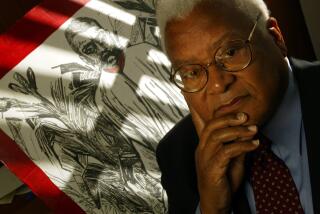Rosewood’s Victory Is Lost on Film
- Share via
It’s always risky business making comparisons between a film and the book it’s based on. A film is geared to mass audiences and must convey the story in as simple and entertaining a manner as possible.
Often many of the book’s characters and plot details are stripped and shorn away in the film. That’s why many of us walk out of a theater after seeing a movie based on a book we’ve read and complain that “the book was better.”
Unfortunately, that’s the case with the film “Rosewood,” directed by John Singleton (“The Fire That Time,” Calendar, Feb. 21). The film shows us in bloody and horrifying detail the tragedy of the town of Rosewood. But it doesn’t show us the triumph. (A tag line at the end of the film hardly qualifies.)
That triumph was well documented by Michael D’Orso in his powerful book “Like Judgment Day.” In fact, D’Orso in his subtitle for the book, “The Ruin and Redemption of a Town Called Rosewood,” practically cries out for the filmmakers to make the victory of the survivors of the violence a principal part of the story. Singleton certainly knew all of this; he wrote the preface to the paperback edition of the book.
Here’s what the film shows us: Rosewood was the mostly black town in western Florida that was virtually obliterated from the map in 1923 after a wild orgy of racial violence. The violence was touched off by an unsubstantiated rumor that an African American male had raped a white woman. White vigilante mobs quickly formed and went on a bloody rampage. When the smoke cleared, nearly every black home had been burned to the ground, and perhaps a dozen or more blacks were killed or wounded, while hundreds of men, women and children were sent fleeing in terror into the woods.
The carnage would have been even greater if not for the heroic act of a white train engineer who whisked the terrified blacks hiding in the woods onto his train and spirited them out of the county. There was also the valiant stand of a small group of whites in a nearby town who confronted the mob at gunpoint and defended the blacks in their town.
Still, at the time, there was no public outcry against the violence and no arrests were made. It was the type of racially motivated violence that all too often was characteristic of the South during the lynch era in America. To Singleton’s credit, the tragedy and heroism of blacks and whites is admirably depicted in the film. But he omits the crucial and compelling reason the Rosewood story made it to the screen in the first place: The violence ultimately attracted national attention and the Rosewood survivors did receive a much belated measure of justice.
Here’s the story that isn’t shown: In 1982, a reporter for the St. Petersburg Times heard the tales about the violence and spent months tracking down and interviewing the survivors. The paper then published a lengthy series on the Rosewood massacre. The next year, CBS’ “60 Minutes” did a segment on Rosewood based on interviews with the survivors. The brief press attention set in motion a remarkable series of events. A handful of the survivors, the descendants of the survivors, and relatives doggedly began a decade-long campaign to get the state of Florida to admit that it was legally culpable for failing to protect the lives and property of the black townspeople of Rosewood and to compensate the victims.
They faced mountainous obstacles. At first state officials refused to consider their claims, law enforcement agencies refused to investigate, and some blacks even questioned the wisdom of pursuing the case. But the group persisted against the odds. Their battle ultimately would involve the local and national press, academics, law enforcement agencies, batteries of attorneys, civil rights leaders, local and state political leaders and the Justice Department.
The survivors partly based their case on the precedent set by the U.S. government’s apology and payments to Japanese Americans for slapping them into relocation camps during World War II and the German government’s payments to Jewish survivors of the Holocaust. Their efforts and labor finally paid off in 1994. In an emotion-packed scene, the Rosewood survivors vividly recounted for the full Florida legislature the night of violence 70 years earlier and the personal pain and trauma they had to live with throughout their lives.
Many of the spectators and legislators were moved to tears by the simple eloquence and dignity they displayed in telling their story. After a bit more partisan political wrangling, the legislature finally capitulated and awarded the survivors $2 million. The moment the claims bill was approved, the spectators gallery erupted in cheers, tears and prayers of thanks.
While the award could never adequately compensate them for their pain, suffering and loss, it was more than a symbolic victory. It marked the first and only time in U.S. history that African Americans got a government body to formally admit that it was liable for a racially motivated act of violence against them. Without their inspiring victory, the tragedy of Rosewood would almost certainly have remained buried deep in history.
There are many lessons that we can learn from the triumph of the Rosewood survivors. The most important is that the crimes of the past must not and should not be forgotten and that justice can be attained if enough people are willing to work and fight for it. To ignore this in the film “Rosewood” is not only regrettable, it’s inexcusable.
More to Read
Only good movies
Get the Indie Focus newsletter, Mark Olsen's weekly guide to the world of cinema.
You may occasionally receive promotional content from the Los Angeles Times.










